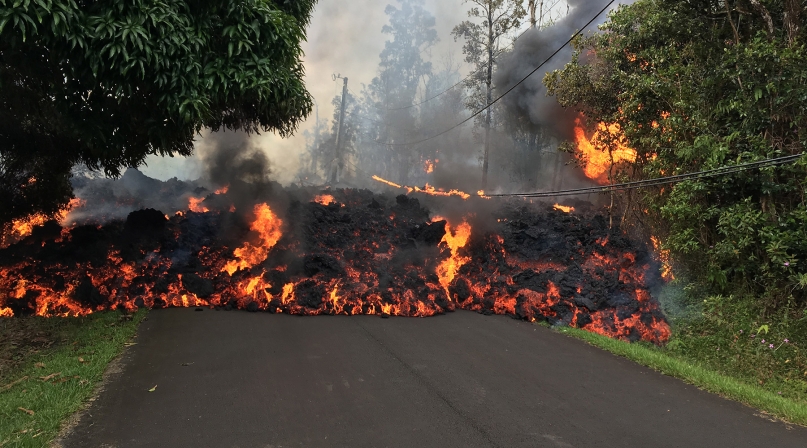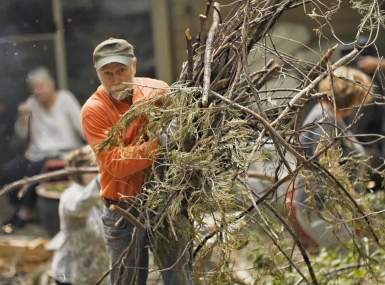Oozing lava, noxious fumes, Hawaiian gods: When a volcano erupts in your county

The Kilauea volcano in Hawaii County has been erupting since May 3, putting the county on high alert
Twelve days into a volcano eruption that sent lava oozing into the streets of her district, Hawaii County Council Member Eileen O’Hara is talking about the history of the region.
“It was a land speculation scam,” she said, referring to the 1958 deal chronicled in Land and Power in Hawaii, which describes how two Colorado businessmen bought 12,000 acres of land on the world’s most active volcano and sold it in thousands of lots.
Learn more
Two years later, 11 subdivisions were underway, including Leilani Estates, sited directly on top of Kilauea Volcano’s East Rift Zone. “They came here to the lava fields of Puna,” O’Hara said. “No roads, no water, nothing. They sold lots.”
“We are now paying for it in many ways because the lack of connectivity between these subdivisions…is compounding the problems we’re having now in terms of circulating people out of harm’s way,” said O’Hara, referring to the Kilauea volcano eruption that started May 3, engulfing 26 homes in Leilani Estates.
“We had a flurry of earthquakes and the USGS had put us on alert that we could see an eruption,” she said. “But we live on the flank of the most active volcano in the world, which has erupted many, many times and people kind of shrug it off.”
Residents were returning home from work May 3 to find out that the volcano was erupting. “Most people had an hour or two to get out, and then they were prevented from going back,” O’Hara said. They weren’t allowed to return for pets or other items during daylight hours “until we had some sort of supervised entry, which was chaotic as all get out.”
Once the volcano erupted, the fume levels from hydrogen sulfide and sulfur dioxide got dangerously high. “It’ll kill ya,” O’Hara said. “Especially if there’s moisture in the air.”
In addition to fumes from the volcano, residents were also concerned about a nearby geothermal plant, which is currently shut down, O’Hara said. Many of the homes are within a mile of the plant, which is home to thousands of gallons of flammable chemicals including pentane. “They always have 50,000 to 60,000 gallons of pentane on hand,” she said. “And knowing that, the community was very concerned when this all started.”
O’Hara called the plant the day the volcano erupted and was told the pentane had been moved, following an EPA plan. She later found out that they had simply moved it about 100 feet from the operations area. “If that were to flame up it would shoot flames for a mile,” she said.
The pentane is now being stored offsite. The plant is working now to “quench” the wells — filling them with water and sealing them with cement, she said. “That has yet to be done and it makes a lot of people very nervous.”
Meanwhile the county was stepping up to the plate itself opening two shelters with help from the American Red Cross and the Salvation Army, using a community center where cots are set up and a newly built sports park with a large gym. A lot of people are “staying in the parking lot in their trucks,” where they are hanging out with their pets, she said. Both shelters are pet friendly. When O’Hara stopped by Monday, about 500 people were at one of the shelters; about 1,500 were displaced in all due to evacuations, she said.
The National Guard is activated and is going door to door in evacuated areas, she said. “Everybody’s taking in people,” she said. A water delivery truck driver took in 12 senior citizens who are her customers.
Another concern is whether those with insured homes will be covered or not. O’Hara said she is trying to work with the insurance commissioner to find out if residents’ insurance policies might cover damages caused by fire, which takes place before a house is engulfed by lava, she said.
She has also met with residents at several Civil Defense meetings at the local high school cafeteria. The first meeting, held the Friday night after the Thursday afternoon eruption, was standing room only, she said. Since then, there have been two more meetings, including one Monday night.
Speaking with a resident whose family goes back generations in the area, O’Hara was given a very unscientific explanation for the volcanic activity — it’s actually a myth being played out between the volcano goddess Madame Pele and the volcano god she replaced years ago.
O’Hara is also keeping in touch with constituents on social media, mainly through her Facebook page, and is fielding phone calls, emails and texts each day from concerned residents.
The biggest worry: “When can we go home?” Residents are allowed into their homes during the day but are not supposed to be in their homes at night, O’Hara said. Civil Defense, based on reports from USGS and other scientists, would make the call when residents can return, she said. “We’re not out of the woods yet.
About Volcanoes
How many active volcanoes are there in Hawaii?
There are three active volcanoes in Hawaii; Mauna Loa and Kilauea on Hawaii Island at Volcanoes National Park. A third, Loihi, is located underwater off the southern coast of Hawaii Island. Kilauea, which has been continuously erupting since 1983, is responsible for the current volcanic activity on the Big Island.
What is the world’s largest volcano
If you’re talking about visible on land, and still active, you’re talking Mauna Loa, again. The volcano is 75 miles long; 30 miles wide; and 13,680 feet (2.6 miles) above sea level. By way of contrast, its sister volcano, Kilauea, is 4,091 feet high.
What is a volcano?
A volcano is an opening on the surface of a planet that allows material warmer than its surroundings to escape from its interior. When this material escapes, it causes an eruption. An eruption can be explosive, sending material high into the sky. Or it can be calmer with only lava flows.
What is a volcanic fissure?
A volcanic fissure is a linear volcanic vent through which lava erupts, usually without any explosive activity.
How many active volcanoes are there in the world?
There are about 1,500 potentially active volcanoes worldwide.
Attachments
Related News

As disasters increase, counties must invest in mitigation
Disasters are becoming more frequent, more severe and more costly, and counties, parishes and boroughs are on the front lines — where the immediate response is handled and where the personal impact is felt.

Micro-grants help fireproof a neighborhood by reducing fuel
Nevada County, Calif. helped communities reduce the vegetation that could easily spread fire in neighborhoods.

National Association of Counties Recognizes National Preparedness Month
NACo recognizes September as National Preparedness Month, an opportunity to highlight the role of counties in preparing for and responding to disasters.
